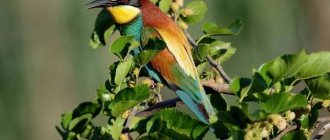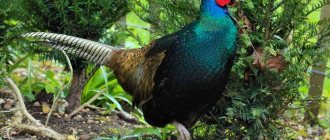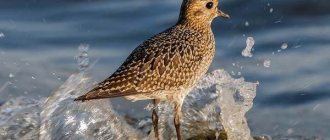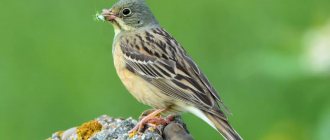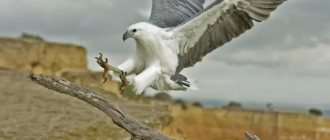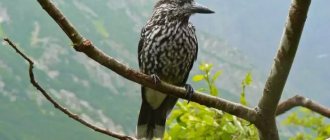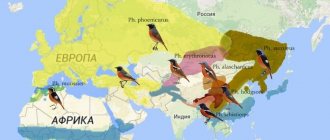| Latin name: | Pernis apivorus |
| English name: | To be confirmed |
| Kingdom: | Animals |
| Type: | Chordata |
| Class: | Birds |
| Squad: | Accipitridae |
| Family: | Accipitridae |
| Genus: | Real honey beetles |
| Body length: | 52-60 cm |
| Wing length: | 38.6—43.4 cm |
| Wingspan: | 135—150 cm |
| Weight: | 600—1000 g |
Description of the bird
The honey beetle is a large predator with a long tail and narrow wings. In the forehead and near the eyes it has short, hard feathers that look like scales. Mesh shields cover the tarsus. The back of adult birds is dark brown, the belly is brown to light with a dark brown transverse pattern or longitudinal streaks. The flight feathers are brown, black above, white below, with dark transverse stripes. The tail feathers have three wide dark transverse stripes - two at the base of the tail and one at the apex. There are individuals of the honey beetle painted in a monotonous brown color. The iris is yellow or orange. The beak is black, the legs are yellow with black claws. Young birds have a light head and light spots on the back.
Shrike
To understand which birds eat wasps and bees, it is necessary to consider another species of bird - the shrike. Most often you can find the following types of this bird:
- gray shrike - length reaches 27 cm, light forehead, short tail, black eye frame, white belly;
- red shrike – length up to 20 cm, bright red tail, sandy color;
- red-headed shrike – length about 18 cm, black back, red-brown head, wide white stripes on the shoulders;
- black-fronted shrike – length up to 24 cm, wide black spot on the forehead, abdomen with a pinkish tint, undulating flight;
- Shrike shrike - length about 18 cm, light gray tail and head, chestnut back, eyes as if outlined in black.
Shrikes make nests from thick branches and dry grass in copses, among swamps and dense bushes, often next to apiaries. These birds do not immediately deal with their prey, but first impale it on the thorns of bushes. This method of fastening makes it easy to cut up prey, which will definitely not slip or fall from the branch. In the warm season, all the thorns of the bushes near the nesting of this bird species are hung with various prey. The rest of the time you can see the remains of feathers and fur on the spines. Shrikes eat mice, small birds, caterpillars, butterflies, but are not averse to eating wasps and bees. Birds are very voracious, so they cause great damage to apiaries.
Feeding characteristics of the honey beetle
— Advertising —
The honey beetle feeds on larvae, pupae and adults of Hymenoptera: bees, wasps, bumblebees, hornets. The bird also eats other insects, such as worms and spiders. The honey buzzard can also hunt frogs, lizards, rodents, and the chicks of other birds. Moreover, if necessary, the birds are fed with wild fruits and berries.
Honey beetles spend little time in flight, as they feed on the ground or, sitting on branches, watch the places from which insects fly out. In this way, the honey buzzard finds the entrance to the underground nest, descends to the ground and uses its claws and beak to dig out the larvae from there. Nests that hang on tree branches are also found and destroyed by the predator. The honey beetle also catches insects flying around it. Before eating an insect, the honey buzzard pulls out its sting.
The honey buzzard feeds its chicks with the larvae of hymenoptera insects, which are rich in protein.
— Advertising —
A day for adequate nutrition, one adult honey beetle destroys up to 5 wasp nests; a chick requires about 1000 larvae, which is why these birds, in addition to insects, hunt frogs, lizards, small rodents and birds, beetles and grasshoppers.
Tit
This is another bird that eats wasps. In winter, when they lack food, tits often fly to the hives. By tapping on the wall of a wasp or bee's home, they wait for prey. Sleepy insects crawl out, and the bird presses them with its paw to pull out the sting, after which it eats the prey.
By the way, this bird behavior makes apiary owners nervous. The tit eats few bees, but constant disturbance makes the insects weaker, which can have a bad effect on their performance during the season.
Bird distribution
The honey buzzard nests in northeastern Sweden to the Ob and Yenisei in Siberia and the southern Caspian Sea on the border with Iran. The bird is migratory and goes to the west and central regions of Africa for wintering. At the end of August and beginning of September, honey beetles gather in large flocks and prepare to make a long journey to warmer climes. Predators arrive at nesting sites in April-May. In flight, it uses air currents, but avoids large bodies of water, trying to fly over them in the narrowest place, for example, on Gibraltar.
The bird prefers to live in forest expanses, in damp and light forests located at an altitude of up to 1000 m above sea level, where you can find enough necessary food. The honey beetle also willingly settles in open spaces with clearings, bushes and swamps. But these predators avoid populated areas and agricultural areas.
Common species of honey beetle
In addition to the common honey buzzard, there is another species called the crested honey buzzard.
Crested or eastern buzzard (Pernis ptilorhynchus)
The bird is medium in size, but larger than the common honey buzzard. The body length is from 59 to 66 cm, the weight ranges from 0.7 to 1.5 kg, the wingspan is 150-170 cm. In the back of the head, long feathers form a pointed crest, which is how the species got its name. The back is brown or dark brown; there is a narrow black stripe on the white throat. The rest of the body is gray. Males are distinguished by a red iris and two dark stripes on the tail. Females are usually darker, with a brown head and yellow irises. There are 4-6 stripes on the tail. Young birds are similar in appearance to females.
The species lives in the south of Siberia and the Far East; in the west, its distribution range reaches Altai and Salair. The crested honey buzzard lives in mixed and deciduous forests where there are open areas. Eats hymenoptera, mainly wasps, as well as cicadas.
Habitat
The honey beetle inhabits the forest zone, including mountainous areas, as well as island forests of other zones. The range covers most of Europe, Asia Minor, Western and Central Asia, Western Siberia and Africa. Wintering areas are sharply separated from the nesting area and are located in the tropical forests of Africa. On the territory of Russia and Ukraine it nests in forest and forest-steppe zones, as well as partially in the steppe zone and mountainous Crimea; migrates everywhere. The nest is located in an area of fairly old light forest, on a slope or near a clearing or clearing. It always gravitates towards deciduous forests; if it nests in pine forests, it chooses an area of mixed forest and makes a nest on a deciduous tree, rarely on pine trees. Nests are found on oak, linden, hornbeam, birch, fruit trees and pine trees.
Area
Male and female honey beetle: main differences
Sexual dimorphism is not typical for the common honey buzzard. In its related species, the crested honey beetle, the female and male differ in the number of stripes on the tail and the color of the iris. In addition, in general, females of this species are darker in color than males.
Buzzard Reproduction
Buzzards are monogamous birds and form one pair for their entire lives. The mating season for birds begins 2-3 weeks after returning from wintering and is accompanied by characteristic dances. At the same time, the male flies vertically into the air, where he flaps his wings over his back, which resembles applause, after which he returns to the ground.
Honey beetles build their nests in tree branches at a height of 10-20 m from the ground, in places where there are open spaces near the forest. Nesting occurs quite late, and therefore fresh branches with young leaves serve as building material for birds. The base is built from twigs and thin twigs; the inside of the nest is lined with fresh leaves and grass, in which the chicks hide in case of any danger. The diameter of the nest is up to 60 cm. Birds use the same nest for several seasons in a row.
The female lays 2-3 brown eggs at intervals of two days, the incubation period lasts from 34 to 38 days. Both the female and the male incubate the eggs, taking turns. Newborn chicks are fed by the female and the male for 18 days.
Then the chicks learn to open the honeycombs on their own and swallow the larvae. At the age of 40 days they begin to fly, but their parents still continue to feed them. At the end of summer, young birds begin an independent life.
The lifespan of the honey beetle reaches 30 years.
flycatcher
The length of this bird is only 15 cm. It is no larger in size than a sparrow. The color of different species may differ: the most common are gray, brown, and olive colors, but individuals with yellow, red, orange, and blue coloring can also be found. The flycatcher feeds on various insects, including wasps and bees.
The beak of all flycatchers is quite wide, which allows them to grab insects directly in flight. The hunt is very unusual. The bird hides in dense foliage, and when an insect flies past, it jumps up and grabs the prey, after which it returns back to ambush.
Now you know which birds eat wasps and bees. By the way, these insects have many other enemies: they are also eaten by spiders, toads, frogs and small animals.
Interesting facts about the bird
- For wintering, honey beetles choose areas with the same topography as for nesting.
- About 100,000 honey beetles fly over Gibraltar every year on their way to Africa for the winter, and another 25,000 over the Bosporus. Buzzards travel in large flocks, which disperse after arrival.
- While hunting, honey beetles sit on tree branches absolutely motionless. Ornithologists once recorded a honey beetle that sat motionless for 2 hours and 47 minutes.
- As they grow up, honey beetle chicks themselves pick out the larvae from the honeycombs that their parents bring them and try so hard that they even sometimes damage their own nests.
- Today, honey beetles are under protection, as their numbers have noticeably decreased. When flying over Southern Europe, this species often becomes the prey of hunters.
